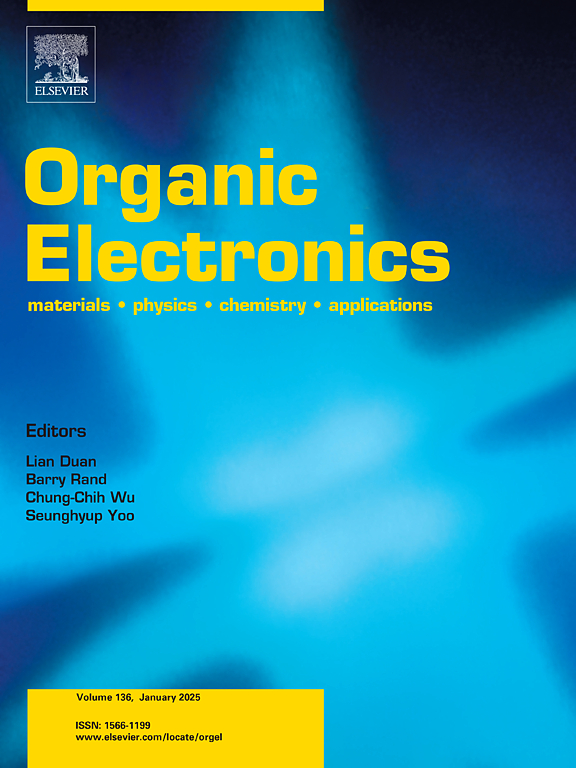Light-emitting electrochemical cells based on mechanochromic, thermally activated delayed fluorescence fish-shaped structures consisting of carbazole derivatives as emitters in the active layer
IF 2.7
4区 工程技术
Q3 MATERIALS SCIENCE, MULTIDISCIPLINARY
引用次数: 0
Abstract
This study surveys the design and synthesis of fish-shaped structures based on carbazole derivatives for applications in light-emitting electrochemical cells (LEECs). Two thermally activated delayed fluorescent dyes (TADF) 5-(3,6-di-tert-butyl-9H-carbazol-9-yl)-10-((3-methoxy-9H-carbazol-9-yl) phenyl) anthracene (dye 1) and 5-(phenoxazine)-10-((3-methoxy-9H-carbazol-9-yl) phenyl) anthracene (dye 2) were synthesized as emitters in the active layer by coupling reaction technique. Separation of the HOMO-LUMO distributions was observed when the HOMOs localized on the methoxycarbazole and phenoxazine derivatives, respectively, and the LUMO consistently localized on the anthracene derivative. The dye consisting of a tert-butyl carbazole derivative showed a lower the variation of singlet-triplet splitting (ΔEST) value of 0.04 eV than the other counterpart, and reverse intersystem crossing (RISC) dominated for both dyes. The crystalline dyes exhibited mechanochromic behavior when the photoluminescence (PL) spectrum of the mechanically stimulated dyes was red-shifted. The space charge limited current (SCLC) technique proved that the dye consisting of a phenoxazine derivative had a higher carrier mobility of 6.14 × 10−4 for holes and 2.12 × 10−4 cm2 V−1 s−1 for electrons in tandem. Based on the mechanochromic behavior of the dyes initially, the fabricated LEECs also exhibited mechanochromic feature, and the EL spectra of the flexible devices showed a red shift in the emission spectra after stretching. In addition, the external quantum efficiency (EQE) of both flexible devices increased to 0.33 % after stretching. Furthermore, iridium complex [Ir(buoppy)2(dmapzpy)]PF6 is used as a promising host for the development of high-performance LEECs. Therefore, brightness and EQE values were increased to 6629 cd m−2 and 7.13 %, respectively.

基于机械致变色、热激活延迟荧光鱼形结构的发光电化学电池,该结构由咔唑衍生物组成,在活性层中作为发射器
本文研究了基于咔唑衍生物的鱼形结构在发光电化学电池(LEECs)中的应用。采用偶联反应技术在活性层上合成了两种热活化延迟荧光染料(TADF) 5-(3,6-二叔丁基- 9h -咔唑-9-基)-10-((3-甲氧基- 9h -咔唑-9-基)苯基)蒽(染料1)和5-(苯恶嗪)-10-((3-甲氧基- 9h -咔唑-9-基)苯基)蒽(染料2)作为发射体。当HOMO-LUMO分别定位在甲氧基咔唑和苯恶嗪衍生物上时,观察到HOMO-LUMO分布的分离,而LUMO始终定位在蒽类衍生物上。叔丁基咔唑衍生物染料单重态-三重态分裂(ΔEST)值的变化较小,为0.04 eV,两种染料均以逆向系统间交叉(RISC)为主。当机械激发染料的光致发光光谱发生红移时,晶体染料表现出机械致变色行为。空间电荷限制电流(SCLC)技术证明了由吩恶嗪衍生物组成的染料具有较高的载流子迁移率,空穴为6.14 × 10−4,电子为2.12 × 10−4 cm2 V−1 s−1。基于染料最初的机械变色行为,制备的LEECs也表现出机械变色的特征,并且柔性器件的EL光谱在拉伸后的发射光谱中出现了红移。此外,拉伸后两种柔性器件的外量子效率(EQE)均提高到0.33%。此外,铱配合物[Ir(buoppy)2(dmapzpy)]PF6被用作开发高性能LEECs的有前途的宿主。因此,亮度和EQE值分别提高到6629 cd m−2和7.13%。
本文章由计算机程序翻译,如有差异,请以英文原文为准。
求助全文
约1分钟内获得全文
求助全文
来源期刊

Organic Electronics
工程技术-材料科学:综合
CiteScore
6.60
自引率
6.20%
发文量
238
审稿时长
44 days
期刊介绍:
Organic Electronics is a journal whose primary interdisciplinary focus is on materials and phenomena related to organic devices such as light emitting diodes, thin film transistors, photovoltaic cells, sensors, memories, etc.
Papers suitable for publication in this journal cover such topics as photoconductive and electronic properties of organic materials, thin film structures and characterization in the context of organic devices, charge and exciton transport, organic electronic and optoelectronic devices.
 求助内容:
求助内容: 应助结果提醒方式:
应助结果提醒方式:


